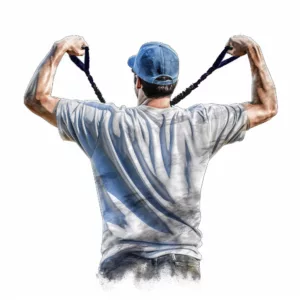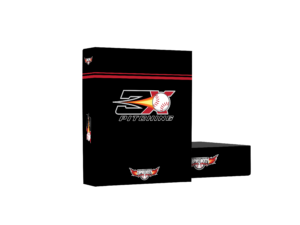 Are you looking for the best arm care after pitching program? You found it!
Are you looking for the best arm care after pitching program? You found it!
Pitching in baseball is more than just throwing a ball; it is a true art form that necessitates a blend of ability, precise technique, and physical strength. Each game puts a huge strain on pitchers' arms, and if they do not receive the appropriate care and training, they are at risk of suffering injuries that will have a negative impact on their performance and may even end their promising careers. This is where the 3X Pitching Velocity Program truly shines.
In this in-depth post, we will look at the important arm care methods that pitchers should focus on after every game. Our emphasis will be on the extraordinary efficacy of the 3X Pitching Velocity Program, which not only plays an important part in preserving good arm health but also in maximizing pitching velocity. We strive to provide pitchers with the knowledge and resources they need to build an arm care regimen that will not only prevent them from injuries but also unlock their full potential on the pitching mound by delivering professional insights, evidence-based recommendations, and practical instructions.
Why is Arm Care Important After Pitching?
The arm experiences tremendous stress and exhaustion after a strenuous pitching session. Prioritizing arm care is critical for preventing injuries, promoting recovery, and improving overall performance. Neglecting proper arm care can result in a variety of problems, including shoulder pain, elbow strain, and even long-term injury. The 3X Pitching Velocity Program focuses not just on enhancing pitching velocity but also on arm maintenance to help pitchers maintain optimal health and lifespan.
How Does the 3X Pitching Velocity Program Improve Arm Care?
 The 3X Pitching Velocity Program is a complete training regimen designed to increase pitching velocity while reducing injury risk. It includes a variety of workouts, drills, and strategies that target the arm muscles and encourage arm care. Pitchers can improve their arm strength, endurance, and flexibility by following the program, allowing them to throw harder without jeopardizing their long-term health.
The 3X Pitching Velocity Program is a complete training regimen designed to increase pitching velocity while reducing injury risk. It includes a variety of workouts, drills, and strategies that target the arm muscles and encourage arm care. Pitchers can improve their arm strength, endurance, and flexibility by following the program, allowing them to throw harder without jeopardizing their long-term health.
- Pre-Pitching Dynamic Warm-up: A dynamic warm-up routine is essential before pitching. Arm circles, shoulder rotations, and bodyweight movements are included in this regimen to enhance blood flow, warm up the muscles, and improve joint mobility. A proper warm-up prepares the muscles for the upcoming vigorous action, lowering the chance of strains and tears.
- Stretching: Stretching exercises are critical for maintaining flexibility and avoiding muscular imbalances. Pitchers should stretch every muscle in their arm, including the rotator cuff, biceps, triceps, and forearm. To enhance flexibility and range of motion, stretch softly and gradually, holding each stretch for 15-30 seconds.
- Foam rolling: Foam rolling is a self-myofascial release method that aids in the release of muscular tension and knots. It is especially useful to the arm muscles since it increases blood flow, lowers muscle tension, and aids in recuperation. To relieve muscle tightness and promote flexibility, foam roll the biceps, triceps, forearms, and shoulders.
Arm Care Routine: Post-Pitching
 Post-Pitching Ice Therapy: Applying ice to the arm after pitching will help reduce inflammation and soothe any pain or discomfort. Place an ice pack on the shoulder and elbow for 15-20 minutes to do ice therapy. This practice aids in the reduction of edema and the promotion of recuperation.
Post-Pitching Ice Therapy: Applying ice to the arm after pitching will help reduce inflammation and soothe any pain or discomfort. Place an ice pack on the shoulder and elbow for 15-20 minutes to do ice therapy. This practice aids in the reduction of edema and the promotion of recuperation.- Active Recovery: After pitching, perform short, low-impact workouts to increase blood flow, cleanse away metabolic waste, and aid in recovery. Swimming, mild running, or utilizing a stationary bike can all help to improve circulation and reduce muscular discomfort.
- Stretching and Mobility Exercises: It is critical to continue stretching and practicing mobility exercises after pitching to preserve flexibility and prevent muscle tightness. Shoulder circles, cross-body stretches, and wrist rotations can all assist to relieve tension and enhance recovery.
- Post-Throwing Strengthening: This includes strengthening overhead with overhead lifting and holds. This also includes rotator cuff exercises to develop strength in all the deceleration movements like external rotation, shoulder horizontal abduction, shoulder abduction, forearm extension and supination. The 3X Pitching Velocity Program has all of these exercises and more programmed for post-pitching training.
- Heavy Load Training Legs and Core: To help stimulate more growth hormone production to heal the body it is ideal to also implement heavy squats, deadlifts, and core routines post-throwing. Avoid high-speed movements and focus on slow controlled heavy load movements to break down the big muscle groups like the legs and core. This is also programmed in the 3X Pitching Velocity Program during the post-game routines.
Frequently Asked Questions
Q1: Is it typical to have arm discomfort after pitching?
A1: Yes, it is common to have some degree of arm pain after throwing. This discomfort, known as delayed onset muscle soreness (DOMS), is generated by micro-tears in the muscle fibers as a result of the intensive activity. Arm care, such as rest, ice therapy, and stretching, can help ease this pain.
Q2: Can the 3X Pitching Velocity Program help to reduce pitching injuries?
A2: While no program can totally eliminate the danger of injury, the 3X Pitching Velocity Program focuses on building good mechanics, strength, and flexibility, which can lower the risk of pitching-related injuries dramatically. It stresses arm care and fitness, allowing pitchers to keep their arms in peak condition.
Q3: How frequently should pitchers do arm care exercises?
A3: Pitchers' normal training routines should include arm care exercises. Arm care exercises should be performed at least 2-3 times a week, even on non-pitching days, to maintain arm health and prevent imbalances.
Q4: Is the 3X Pitching Velocity Program effective at increasing pitching velocity?
A4: The 3X Pitching Velocity Program is designed exclusively to improve pitching velocity. It emphasizes explosive power, mechanics, and strength in the pitching motion. Pitchers' velocity can improve significantly if they adhere to the regimen religiously.
Q5: Are there any dietary advice for proper arm care?
A5: While appropriate nutrition is important for overall health and recovery, there are no dietary advice specifically for arm care. However, eating a well-balanced diet, staying hydrated, and getting enough protein will help with muscle repair and overall performance.
Q6: Does the 3X Pitching Velocity Program aid pitchers of all ages?
A6: Yes, pitchers of all ages and ability levels can benefit from the 3X Pitching Velocity Program. The curriculum may be adapted to individual pitchers' specific needs and talents, ensuring that they receive the necessary training and arm care advice.
The Best Arm Care After Pitching Program!
 Are you ready to take your pitching game to the next level? Don't pass up the chance to transform your arm care regimen and unleash your ultimate potential on the pitch. The 3X Pitching Velocity Program is your passport to increased pitching velocity, improved performance, and injury prevention.
Are you ready to take your pitching game to the next level? Don't pass up the chance to transform your arm care regimen and unleash your ultimate potential on the pitch. The 3X Pitching Velocity Program is your passport to increased pitching velocity, improved performance, and injury prevention.
Consider how much confidence and control you'll gain as you learn to pitch while keeping your arm healthy and resilient. With the 3X Pitching Velocity Program, you'll have access to a complete training method created by industry professionals. It combines cutting-edge tactics, tried-and-true workouts, and personalized instruction to help you improve your pitching mechanics, gain strength, and increase your velocity.
Don't let injuries or a lack of progress slow you down. Join the ranks of successful pitchers who have experienced the 3X Pitching Velocity Program's transforming power. Act today to secure your future as a dominant pitcher. Visit our website to learn more and discover the keys to accomplishing your pitching objectives. The 3X Pitching Velocity Program is where your ambition of becoming a top-tier pitcher begins.


 Post-Pitching Ice Therapy: Applying ice to the arm after pitching will help reduce inflammation and soothe any pain or discomfort. Place an ice pack on the shoulder and elbow for 15-20 minutes to do ice therapy. This practice aids in the reduction of edema and the promotion of recuperation.
Post-Pitching Ice Therapy: Applying ice to the arm after pitching will help reduce inflammation and soothe any pain or discomfort. Place an ice pack on the shoulder and elbow for 15-20 minutes to do ice therapy. This practice aids in the reduction of edema and the promotion of recuperation.


What should I do if my side keeps on hurting when ever pressure is added or whenever I throw.
I’m not a doctor, but I can offer some general advice based on my experience in baseball and sports science. Persistent side pain when throwing could be due to various factors, including muscle strain, improper mechanics, or overuse. Here are some steps you can consider:
1. Rest and Recovery: Give your body time to heal. Avoid activities that aggravate the pain, and allow your side muscles to recover.
2. Proper Warm-Up: Ensure you’re warming up adequately before throwing. Incorporate dynamic stretches and exercises to prepare your body for the demands of pitching.
3. Mechanics Evaluation: Have a coach or pitching expert assess your throwing mechanics. Poor mechanics can place excess strain on your side muscles.
4. Gradual Return: If the pain subsides, start throwing again gradually. Focus on proper form and limit the intensity and volume initially.
5. Core Strengthening: Strengthen your core muscles, as they play a crucial role in stabilizing your torso during the pitching motion.
6. Consult a Professional: If the pain persists, I recommend attending our 3x pitching velocity camp so that you can get a complete in-person analysis and we can set you on the path to recovery.
Remember, it’s essential to prioritize your health and recovery to avoid further injury. Always seek professional advice when dealing with persistent pain to ensure you get the right guidance for your specific situation.